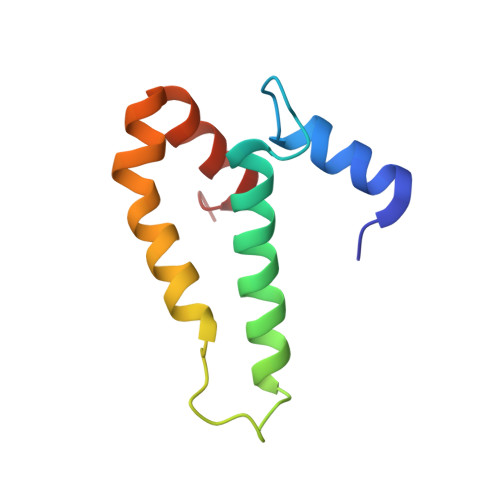The Conformational Landscape of the Ribosomal Protein S15 and Its Influence on the Protein Interaction with 16S RNA.
Crety, T., Malliavin, T.E.(2007) Biophys J 92: 2647-2665
- PubMed: 17259282
- DOI: https://doi.org/10.1529/biophysj.106.092601
- Primary Citation of Related Structures:
2FKX - PubMed Abstract:
The interaction between the ribosomal protein S15 and its binding sites in the 16S RNA was examined from two points of view. First, the isolated protein S15 was studied by comparing NMR conformer sets, available in the PDB and recalculated using the CNS-ARIA protocol. Molecular dynamics (MD) trajectories were then recorded starting from a conformer of each set. The recalculation of the S15 NMR structure, as well as the recording of MD trajectories, reveals that several orientations of the N-terminal alpha-helix alpha1 with respect to the structure core are populated. MD trajectories of the complex between the ribosomal protein S15 and RNA were also recorded in the presence and absence of Mg(2+) ions. The Mg(2+) ions are hexacoordinated by water and RNA oxygens. The coordination spheres mainly interact with the RNA phosphodiester backbone, reducing the RNA mobility and inducing electrostatic screening. When the Mg(2+) ions are removed, the internal mobility of the RNA and of the protein increases at the interaction interface close to the RNA G-U/G-C motif as a result of a gap between the phosphate groups in the UUCG capping tetraloop and of the disruption of S15-RNA hydrogen bonds in that region. On the other hand, several S15-RNA hydrogen bonds are reinforced, and water bridges appear between the three-way junction region and S15. The network of hydrogen bonds observed in the loop between alpha1 and alpha2 is consequently reorganized. In the absence of Mg(2+), this network has the same pattern as the network observed in the isolated protein, where the helix alpha1 is mobile with respect to the protein core. The presence of Mg(2+) ions may thus play a role in stabilizing the orientation of the helix alpha1 of S15.
Organizational Affiliation:
Laboratoire de Biochimie Théorique, CNRS UPR 9080, Institut de Biologie Physico-Chimique, 75 005 Paris, France.














